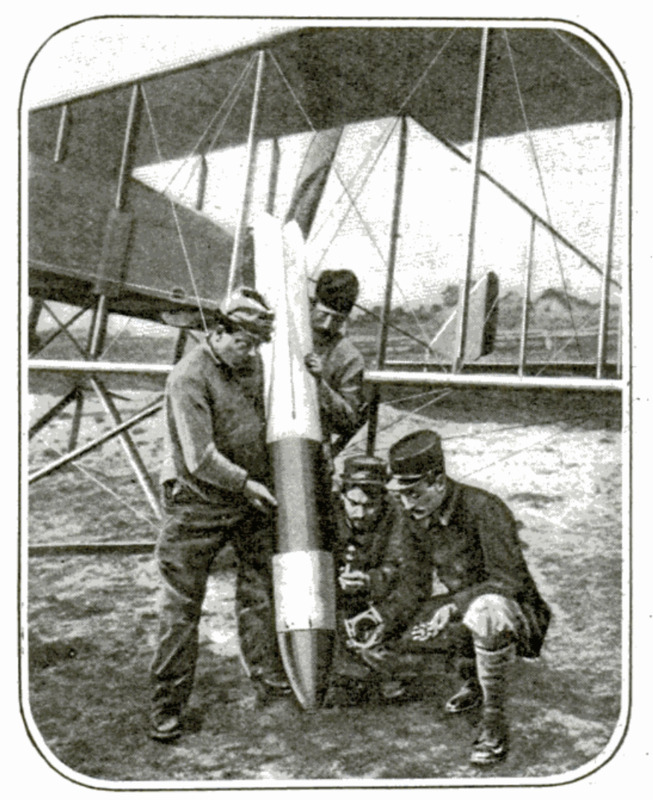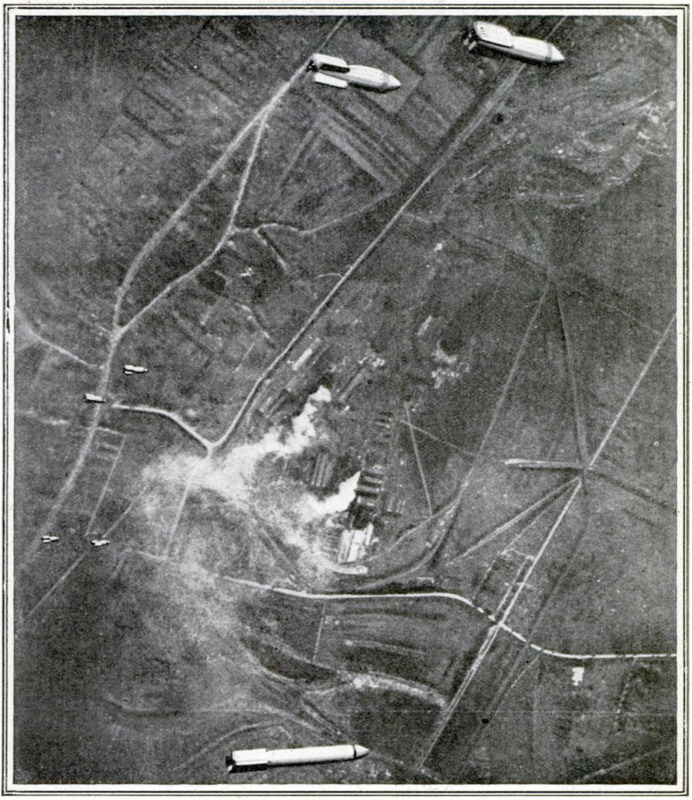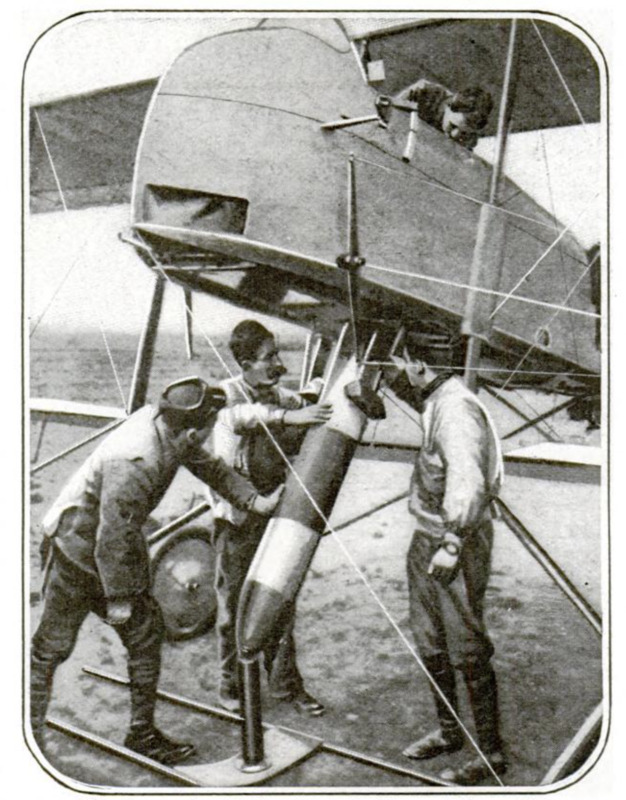-
Titolo
-
Dropping Death from the Skies
-
Article Title and/or Image Caption
-
Dropping Death from the Skies. The bomb dropper and his murderous winged weapons which deal quick and ghastly death
-
Caption 1: Modern "fletched" airplane bomb. Note streamline form, size, and weight, as shown
-
Caption 2: A wonderful photograph taken from a French airplane while bombing a German factory in Lorraine. Seven bombs may be seen in the air, all released together by the same machine
-
Caption 3: Slipping a bomb into an airplane. The tail is
being inserted smoothly into the discharge tube
-
extracted text
-
HARDLY had the airplane been
adopted asa military weapon some
four years before the outbreak of
the great European war, when the pos-
sibilities of bomb dropping began to be
considered. To the general public at
least, it seemed easy to wipe out a fort,
to demolish a bridge, or to blow up a
battleship by the simple expedient of
dropping on it a hundred pounds of high
explosive. Engineers knew better. Long
before the first
Zeppelin flew over
London, it was
pointed out that
it was hard to hit
a target on the
ground from an
elevated platform
moving at fifty
miles an hour and
more, because al-
lowances had to
be made for
deflecting winds
for the horizontal
motion acquired
by the bomb from
the airplane. To
hit a target the
plane's height
and speed over
ground had to be
known with almost
impossible ac-
curacy, and even
if known, an in-
finitesimal hesita-
tion in releasing the bomb would spoil the
aim. A truly super-human sense of time
was demanded. The difficulty, only
vastly exaggerated, is the same as that
which a hunter experiences in hitting
running or flying game by aiming ahead
of the target. Whether the target moves
swiftly or the gun and the missile have a
fast motion of their own, aiming ahead
causes all the trouble.
On the whole, the public has been more
far-seeing than military engineers. It
reckoned with moral effects in its own
unreasoning way rather than with phy-
sical principles. Bomb-dropping has be-
come an indispensable mode of attack.
‘The civilians of all the warring powers
protest against it in vain. Germans de-
nounce the “baby killing” tactics of the
Allied aviators as hotly as England de-
nounces the German slaughter of defense-
less woman and children. Whether or
not fortified places
are bombed, civil-
iansinvariably suf-
fer. A dozen
bombs may be
aimed at a muni-
tions factory.
One, perhaps, finds
its mark. The
rest are scattered
over a residential
quarter with an
effect too ghastly
to be described.
Aim at a powder
mill and you hit a
hospital.
As the war pro-
gressed, bombing
became ‘more ac-
curate, although
the misses still far
outnumbered the
hits. The reason
for this increased
accuracy is re-
vealed in the truly
remarkable photographs of French bombs
which we publish herewith and which
have been permitted to reach this coun-
try by a lenient censor.
The bombs pictured have been called
“aerial torpedoes.” They do bear an
outward resemblance to the naval tor-
pedo. For all that, the designation is
incorrect. The internal construction
bears little resemblance to that of a naval
torpedo. The bomb shown is provided
with tail planes to make it fly straight—
a tail which has the same effect on the
bomb as the tail feathers have on an
arrow. In addition there is a ‘pro-
peller” to sensitize the percussion fuse
during the bomb’s fall.
Particular attention is directed to the
extraordinary photograph which shows
seven bombs flying through the air after
having been released nearly simultane-
ously. They do not drop. They liter-
ally rush through the air like naval
torpedoes, thereby to a certain extent
justifying their alias. Released from a
machine which is traveling at a speed of
ninety miles an hour, they necessarily
have, for a time, the forward motion of
that machine and actually travel hori-
zontally. Realizing all this, their dc-
signers gave them an ideal streamline
form. In the picture only the lowest
bombs have begun to turn downward
visibly and to drop vertically. The up-
permost one is seen gliding like an air-
plane itself in spite of its great weight,
in spite of its comparatively small surface
and in spite of the fact that it has only a
belly in place of wings. The moment
bombs drop from their tubes (one-third as
slowly as they are swept ahead by the
plane) they are swung by momentum and
air pressure on |
their tail planes
into a nearly |
horizontal po-
sition. In that |
position their
shape encoun- |
ters practically
no resistance
from ahead
but a great re-
sistance in the
direction of
gravity, not
only because in
trying to fall
they must
cleave the air |
with their big
broad sides,
but chiefly be-
cause in drop-
ping they are
nowopposedby
the inertia of
the air encoun- |
tered in falling,
and, in addi-
tion, the much |
greateramount
of air encoun-
tered in mov-
ing ahead. As |
long as momentum continues, falling is
greatly retarded, and, with practically no
head resistance, it is bound to continue
indefinitely. But as soon as actual falling
begins, the head dips a little, aided by the
tail planes. In this position the fall itself
will preserve and increase the horizontal
speed, just as in coasting down hill in a
sleigh. If the total surface of a correctly
designed bomb were not so extremely
small in proportion to its weight, it
would seemingly never reach the ground.
Balloonists sometimes threw empty
bottles from their baskets. They mar-
velled at the crazy antics performed by
the bottles and the long time they took
in reaching the ground. It was the ap-
proximation of streamline form that de-
layed the bottles.
Bombing is like torpedoing. Bombs
have assumed the shape of torpedoes
not to prolong their fall, a thing in it-
self ratlier unfavorable, but because the
lower winds have practically no influence
over a torpedo.
Guided by its
tail, the tor-
pedo-shaped
bomb simply
turns its sharp
nose against
the wind and
cleaves it
without deflec-
tion.
That is why
bomb-drop-
ping is more
accurate than
it was at the
outbreak of the
war. More-
over,bombsare
dropped on the
shotgun or
blunderbuss
principle. In
other words,
they are re-
leased a half a
dozen or more
at atime. One
at least will
find its mark.
By releasing
bombs in quick
succession,
errors in judging altitude and speed are
readily corrected, because the bombs
scatter principally along a line parallel
with the path of the machine.
-
Autore secondario
-
Carl Dientsbach (writer)
-
Kadel and Herbert (photos)
-
Lingua
-
eng
-
Data di rilascio
-
1918-04
-
pagine
-
518-520
-
Diritti
-
Public Domain (Google digitized)
-
Archived by
-
Filippo Valle
-
Alberto Bordignon (Supervisor)






